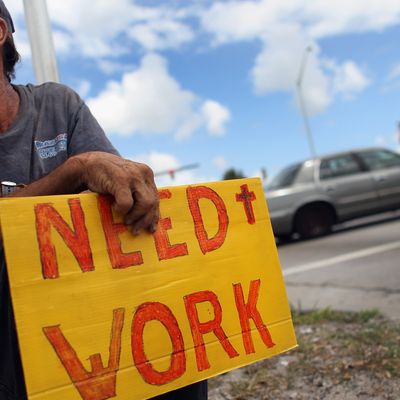
The Most Important Number in America is out, and whew, does it stink.
The U.S. economy added only 96,000 jobs in August, according to the Bureau of Labor Statistics’ monthly non-farm payrolls report. (Economists had expected at least 125,000 new jobs.) The labor force shrunk by 367,000 to 63.5 percent, its lowest level since 1981, and numbers for June and July were also revised downward. Unemployment ticked down to 8.1 percent — a number that still bespeaks massive, structural joblessness — but only because the labor force got smaller as well.
In last night’s convention speech, when President Obama used the term “Great Recession” to describe our current economic torpor, many (including me) rolled our eyes, thinking he was trotting out a hyperbolic descriptor meant to scare people into voting. To me, “Great Recession” evokes images of bread lines, orphans in the streets, and thugs siphoning gasoline from your grandma’s Plymouth. Not exactly what today’s economic picture seemed to look like.
But after today’s report, I recant my skepticism. This is indeed a Great Recession, one that has introduced a new era of lowered expectations and been exacerbated by Washington’s indifference. When I went across the country last month, speaking to people on Main Streets about their economic woes, I was shocked by the extent of the hopelessness many felt — the seemingly illogical sense that, no matter who was in the White House or how the larger economy fared, their chances of regaining their personal footing were slim to none.
It’s true that the macro picture looks somewhat brighter than it did when last month’s job numbers came out. Europe is possibly back from the brink, and the Fed has signaled its willingness to give a cortisone shot to the economy with more quantitative easing (a step that, with today’s jobs number, is almost a sure thing).
But when you’re reduced to cheering up a dismal jobs report by arguing “well, at least now the Fed is more likely to take an emergency stimulative measure!”, you’ve already conceded that the folks on Main Street are right to feel nothing but pessimism.
Because, remember, that’s what QE3 is: an emergency measure, meant for use in a bona fide crisis. The fact that some of us now expect policymakers to use these kinds of tools on a more or less regular basis is a reflection of how much we’ve acclimated to our situation. Emergency measures have become, to use this magazine’s least-favorite phrase, the new normal.
There may not be an immediate electoral response to today’s report. Despite the prognostication you’ll hear all day today on cable news shows, it may not make President Obama more or less likely to get reelected.
But make no mistake: A jobs report that reveals that all the major trends (hours, factory payrolls, long-term unemployment) are moving in the wrong direction, and that 5 million Americans have been out of work for at least 27 weeks, is not a ho-hum piece of economic data. It’s a jolt in the arm to those of us who have been downplaying the extent of America’s economic troubles to suit our political and psychic needs. And it’s a much-needed reminder that the Great Recession of which Obama spoke last night is still very real, and still very much ours to live through.





























